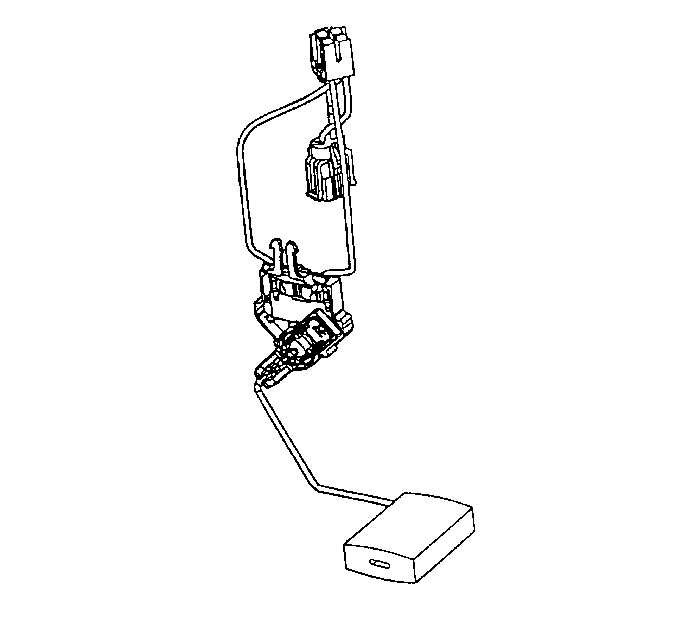Tools Required
| • | J 34730-1A Fuel Pressure Gauge |
| • | J 39765 Fuel Sender Lock Nut Wrench |
Removal Procedure
Caution: Provide proper ventilation when working with fuel in enclosed areas where fuel vapors can collect. The lack of adequate ventilation may result in personal injury.
Caution: Always wear safety goggles when working with fuel in order to protect the eyes from fuel splash.
Notice: Do Not handle the fuel sender assembly by the fuel pipes. The amount of leverage generated by handling the fuel pipes could damage the joints.
- Relieve the fuel system fuel pressure. Refer to the Fuel Pressure Relief .
- Drain the fuel tank to at least 3/4 of a tank full. Refer to Fuel Tank Draining .
- Remove the fuel sender assembly. Refer to Fuel Sender Assembly Replacement .

Important: The modular fuel sender support assembly will spring-up when the locking ring is moved.
Disassemble Procedure
- Note the position of the fuel sender strainer for installation (2).
- Support the reservoir with one hand and grasp the fuel sender strainer with the other hand.
- Pull the fuel sender strainer off of the fuel sender assembly.
- Inspect the fuel sender strainer. If the fuel sender strainer is contaminated, the fuel tank should be cleaned. Refer to Fuel System Cleaning .
- Discard the fuel sender strainer after inspection.
- Disassemble the electrical connectors from the sensor assembly of the fuel pump and the cover assembly.
- Disassemble the fuel level sensor assembly (3).


Assemble Procedure
- Assemble the fuel level sensor assembly.
- Assemble the electrical connectors to the fuel pump and the cover assembly.
- Position the new fuel sender strainer (2) on the modular fuel sender and push on the outer edge of the fuel sender strainer until the fuel sender strainer is fully seated.


Installation Procedure
- Install the fuel sender assembly (1) into the fuel tank. Refer to Fuel Sender Assembly Replacement .
- Install new lip seal on modular fuel sender assembly. Always use a new lip seal when servicing modular fuel sender unit.
- Lightly lubricate the inside diameter of the lip seal with clean engine oil.
- Install modular fuel sender assembly (1) into the fuel tank.
- Seat the lip seal into tank opening.
- Align arrow on top of the fuel sender cover to arrow on the fuel tank.
- Slowly apply pressure to the top of the spring loaded sender until the lip seal is flush between the fuel tank and the fuel sender cover.
- Install the fuel tank. Refer to Fuel Tank Replacement .
- Lower the vehicle.
- Add fuel to the fuel tank.
- Install the fuel tank filler pipe cap.
- Install the negative battery cable.
- Install the intake manifold top cover.

Notice: Use the correct fastener in the correct location. Replacement fasteners must be the correct part number for that application. Fasteners requiring replacement or fasteners requiring the use of thread locking compound or sealant are identified in the service procedure. Do not use paints, lubricants, or corrosion inhibitors on fasteners or fastener joint surfaces unless specified. These coatings affect fastener torque and joint clamping force and may damage the fastener. Use the correct tightening sequence and specifications when installing fasteners in order to avoid damage to parts and systems.
Tighten
Tighten the locking nut and tighten locking nut to 34 N·m
25 lb ft).
Be sure that the lip seal provides a snug seal between the modular unit and the fuel tank.

| 12.1. | Turn ignition switch to ON for 2 seconds. |
| 12.2. | Turn the ignition switch to OFF for 5 seconds. |
| 12.3. | Turn the ignition switch ON. |
| 12.4. | Check for fuel leaks. |
Notice: Use the correct fastener in the correct location. Replacement fasteners must be the correct part number for that application. Fasteners requiring replacement or fasteners requiring the use of thread locking compound or sealant are identified in the service procedure. Do not use paints, lubricants, or corrosion inhibitors on fasteners or fastener joint surfaces unless specified. These coatings affect fastener torque and joint clamping force and may damage the fastener. Use the correct tightening sequence and specifications when installing fasteners in order to avoid damage to parts and systems.

Tighten
Tighten the nuts to 3 N·m (27 lb in).
